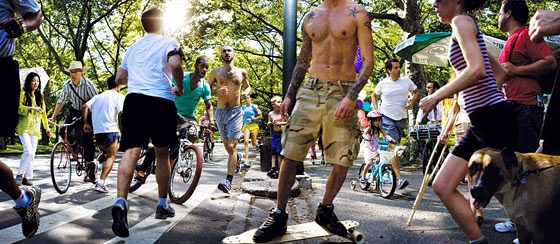 |
It's chaos out there... but why?
Photo Credit: NY Magazine |
There's been a lot of commentary in urbanist circles the past few days about the
death of Jill Tarlov in Central Park, who was struck by a spandexed road cyclist on the primary loop road. While its obvious that the cyclist was 100% responsible for the tragic crash, an interesting question concerns the specific conditions that lead repeatedly to these sorts of accidents (and countless near-misses). How does the texture and design of the Central Park loop encourage or discourage safe behavior by both cyclists and pedestrians?
I propose a somewhat counterintuitive theory: that the existence of signalized intersections (of which there are many) actually contribute to the dangerous pedestrian-cyclist interactions that occur on a daily basis in Central Park. First, consider that spandexed cyclists will always try to conserve their speed (rightly or wrongly). Due to congestion and road disrepair, New York City has few local opportunities for cyclists to achieve sustained high speeds. Rightly or wrongly, this means the Central Park loop will attract many aggressive spandexed cyclists.
Next, consider that the vast majority of pedestrians don't utilize structured intersections to cross the roadway--they don't need to. People can simply cross the gap anywhere (it is a nice green public park, after all). Cyclists, meanwhile, use the ample road width to subtly adjust and filter through pedestrians, joggers, slower cyclists etc. and proceed on their way. This is what happens over 99% of the road space on the loop. The mutual appreciation of shared space forces a level of awareness and emergent cooperation that minimizes the potential for crashes.
Typically when cyclists approach red lights in the loop there are no pedestrians around, so they just roll through. No harm done. Conversely, when a pedestrian faces a 'do not walk' sign, there are often no cyclists around, so they just cross. Again, no harm done. At signalized intersections, however, this all breaks down. What happens at intersections during peak times is that the unofficial norm of mutual filtering comes into direct conflict with the explicit directions of the signal lights. This creates chaos in several ways.
Some pedestrians follow the signals, and some follow the norms. Pedestrians who follow the signals and wait for a 'walk' sign clump up and create a large group of people that, when finally crossing, minimizes the gaps available for spandexed cyclists to filter through. This creates a dangerous situation.
Similarly for the cyclists, some stop at red lights, and some don't. When many (typically casual) cyclists stop at red lights, they clump up and create a barrier that minimizes the gaps available for spandexed cyclists to filter through. Signalized intersections, perversely,
create the congestion which leads to unsafe pedestrian-cyclist interactions.
Signalized intersections are extremely expensive to maintain, and should be replaced with other passive traffic-calming devices that would better encourage safe interactions between pedestrians and cyclists (and cars, although given their low volume its surprising they're still allowed in the park). Signals were designed for auto-centric roads, and their continued existence on Central Park's pedestrian- and cyclist-dominated loop serves no purpose other than to confuse and muddle what should be pleasantly mutualistic and safe human interactions. So let's save some money, save some lives, and give Central Park back to its people.






